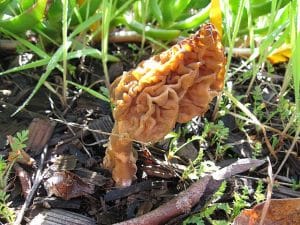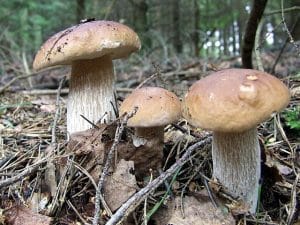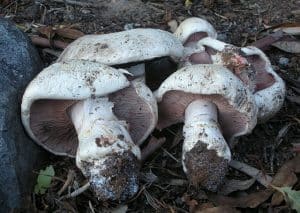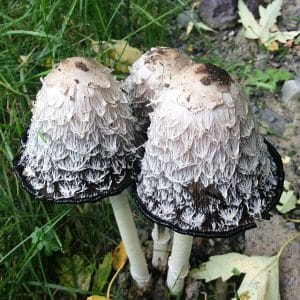Northern California is home to a wide variety of fungi, including many species of edible mushrooms that foragers can explore the area to find. The following list includes a few fungi that both beginner and experienced foragers can find!
Blushing Morel (Morchella rufobrunnea)

The Blushing Morel mushroom, also known as the Woodchip Morel, is found throughout the West Coast and often grows in disturbed soil. You can also spot this fungus growing in areas with woodchips, including landscaped areas. This mushroom can be found growing in both single sprouts and in clusters, around fire pits, compost piles, and near dirt basements. The Blushing Morel sprouts during the spring, but can sometimes be found throughout the year. The cap is oval-shaped and has yellow-brown ridges, while the spores are more yellow-orange. The Morchella tridentina is most similar to the Blushing Morel, yet grows in mountainous forests.
King Bolete (Boletus edulis)

King Bolete mushrooms are also known as Penny Bun or Porcini mushrooms. This mushroom grows in deciduous and coniferous forests, yet is not the easiest mushroom to find, given that it is beloved and quickly eaten by wildlife. They produce spores on a pore surface and not on gills. They can be found growing during the summer and autumn seasons. The body is comprised of a brown cap, averaging 12 inches in diameter, with an off-white stalk that reaches an average of eight inches tall. The King Bolete is difficult to cultivate because it is symbiotic with local tree species. It is one of the most sought-after wild edible mushrooms due to its texture and flavor.
Oyster Mushroom (Pleurotus ostreatus)

The Oyster mushroom is another variety of fungi named for its appearance, as the body resembles an oyster shell with decurrent gills that directly run from the stem. Oyster mushrooms range from white to light brown and often grow on deciduous hardwoods, including beech and aspen trees. The cap of this mushroom often reaches between two and 10 inches across in a shelf-like formation. It is also another type of saprotrophic mushroom, which grows from dying or dead trees commonly during the summer and fall seasons. Aside from appearance, oyster mushrooms often omit a mild anise odor, making it slightly easier to identify.
Pacific Golden Chanterelle (Cantharellus formosus)

The Pacific Golden Chanterelle mushroom is native to the northwest region of North America. This fungus is orange and yellow with a funnel-shaped body that consists of a smooth cap and gill ridges underneath. The Pacific Golden Chanterelle fruits in July to December, in coniferous forests, and can be identified by its mild and sweet odor. This variety of chanterelle is more commonly found in younger forests, near Douglas fir and hemlock trees, and is known to have a light floral taste.
Salt-Loving Mushroom (Agaricus bernardii)

The Salt-Loving Mushroom is a short fungus that often grows in salt marshes and coastal grassland. The caps are flattened and a greyish-white color, with the gills a dull pink color in younger mushrooms. The older the mushroom, however, the darker the color of the gills will become, turning into a reddish-brown. This fungus prefers sandy soils and areas with a higher salt concentration in the soil, hence its given name.
Shaggy Mane (Coprinus comatus)

Shaggy Mane mushrooms are another easily identifiable mushroom. This mushroom is also known as the Lawyer’s Wig mushroom, It is a type of Inky Cap mushroom. This mushroom has three lookalikes, including the common Ink Cap, Snowy Ink Cap, and Wooly Ink Cap mushrooms, and is also closely related to other inky cap mushroom varieties. The Shaggy Mane mushroom commonly grows on lawns and is a primarily white mushroom that resembles the powdered, white wigs that were once commonly associated with lawyers and judges. It is important to know that when foraging these mushrooms, they dissolve into a black residue even while fresh, and will gradually dissolve more with age. The gills are known for producing an ink-like residue, hence the name Inky Cap mushroom.
This list consists of several varieties that are perfect for beginning foragers, as well as beloved varieties by experienced foragers!






